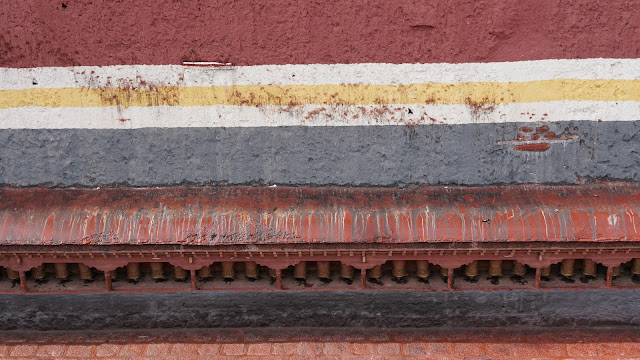Start: Sakya
1. Sakya Monastery 萨迦寺
End: Saga
Sakya Monastery 萨迦寺
The 1073 built Sakya Monastery, also known as Pel Sakya translated as "Pale Earth" are with buildings in ash grey colour with white and red vertical stripes. The colouring symbolises the Rgisum Gonpo (the trinity of bodhisattvas) and stands as a mark of Sakya authority. It was founded by Khon Kunchok Gyapo was originally a Nyingmapa monk of the powerful House of Khon of Tsang, who became the first Sakya Trizin (Trizin is the traditional title of the head of the Sakya school).
There are actually two monasteries, on either side of the river Trum-chu - north and south. The hillside northern monastery is largely reduced to picturesque ruins is undergoing restoration work. Most of the southern monastery was burned down in the 16th century. It was only restored to its previous size in 1948.
The monks were mopping the floor when we visited. A mopping cloth was tied to the bottom of a huge gunny sack of barley, so the monk was moving the weight as he mopped through the whole chapel - exercised and cleaned.
 |
| Monk's quarters |
The initial plan was to head to Tibet's side of Everest Base Camp (EBC) from Sakya but it was cloudy and snowing. Driver and guide proposed if we wanted to swap the itinerary and only visit EBC on the way back to Lhasa as the probability of seeing the peak of the mountains is low due to the weather. The weather forecast a week later, when we returned was clear so the itinerary was changed to Saga from Sakya.
Saga is located in the north western area of Shigatse prefecture, at a junction of three main roads from Shigatse, Everest region, Tibet-Nepal border towns Gyirong and Purang, and western Tibet. So Saga was also our last stop before crossing over to Ngari Prefecture.
Side note: Kinosaki or Kurashiki or Koya-san?









0 comments